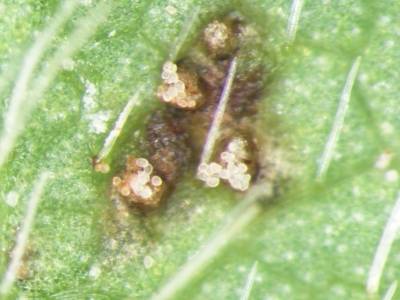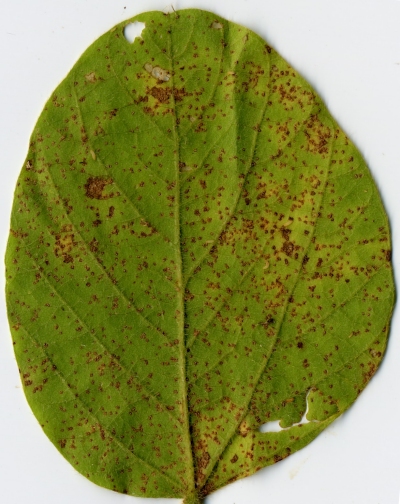Australasian Soybean Rust
 Causal Agent
Causal Agent
Phakopsora pachyrhizi
Hosts
P. pachyrhizi is capable of infecting more than 90 species of legumes; however, the number of legumes infected in nature is unknown. Kudzu is widespread in the United States and could serve as a reservoir for the soybean rust pathogen.
Symptoms

Identification
 Early symptoms of soybean rust resemble bacterial pustule (Xanthomonas axonopodis pv. glycines) and brown spot (Septoria glycines). Soybean rust can be distinguished from bacterial pustule and brown spot by examining
the lesions under a hand lens (20×) or dissecting microscope. The mature soybean rust
lesion contains cone-shaped pustules with a pore on the top with spores inside or
on top of the cone.
Early symptoms of soybean rust resemble bacterial pustule (Xanthomonas axonopodis pv. glycines) and brown spot (Septoria glycines). Soybean rust can be distinguished from bacterial pustule and brown spot by examining
the lesions under a hand lens (20×) or dissecting microscope. The mature soybean rust
lesion contains cone-shaped pustules with a pore on the top with spores inside or
on top of the cone.
Control
All commercial varieties currently available are highly susceptible. Current research includes screening germplasm for resistance and evaluating fungicide efficacy. Early detection is required for the most effective management of soybean rust. Monitoring soybean fields and adjacent areas is recommended throughout the growing season. Fungicide applications may reduce yield loss, depending on the plant developmental stage, time when soybean rust is detected, and fungicide application method. For efficacy information on fungicides labeled for use on soybean, please contact your local county extension office.
